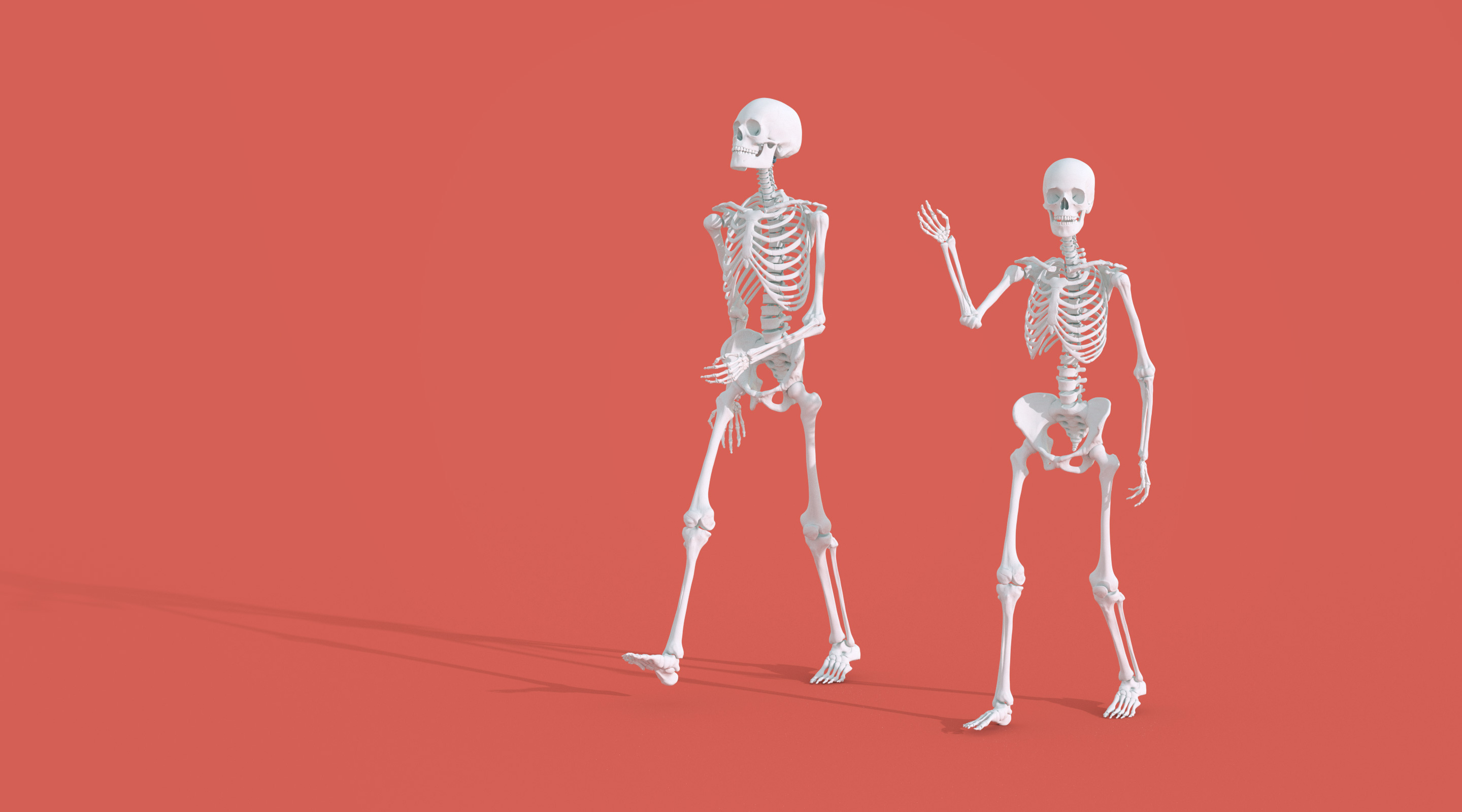Males Are the Taller Sex. Estrogen, Not Fights for Mates, May Be Why.

Men are taller on average than women, but that may not be a trait that evolved through selection. It might be a purely incidental result of estrogen’s effects on bone growth.
Olena Shmahalo/Quanta Magazine; source: 3D Molier International
Introduction
One of the most obvious physical differences between men and women are their average sizes. Men are, on the whole, taller. The standard explanation found in textbooks — sexual selection and male competition — goes all the way back to Charles Darwin: “There can be little doubt that the greater size and strength of man, in comparison with woman, together with his broader shoulders, more developed muscles, rugged outline of body, his greater courage and pugnacity … have been preserved or even augmented during the long ages of man’s savagery, by the success of the strongest and boldest men, both in the general struggle for life and in their contests for wives,” he wrote in The Descent of Man.
Essentially, were it not for men’s fiercely physical infighting for access to mates, all people would presumably be equally sized. Evolutionary psychology extends that argument to say that these biological directives underlie our behaviors; men can’t help but be aggressive and competitive, while women are by nature sneaky, conniving and choosy.
“There’s a lot of importance put on our differences in body size, as if that’s the keystone fundamental sex difference,” said Holly Dunsworth, a biological anthropologist at the University of Rhode Island. “This is what people think is fact, and if you don’t agree, they think you’re denying science.”
But in a recent paper in Evolutionary Anthropology, Dunsworth showed that the science points another way. She argued not only that the evidence that human body size is driven by sexual selection is quite flimsy but that a much better explanation has been hiding in plain sight in the medical and anthropological literature. It’s not about competition; it’s about bone development and how the hormonal output of ovaries and testes affects it differently.
“With humans, we’ve been fixated on this one thing, almost to the exclusion of a lot of other ideas,” Dunsworth said. She isn’t claiming that sexual selection has nothing to do with human height differences, only that this specific hypothesis isn’t well supported, and that it’s long past time that other ideas were explored. What’s at stake, she says, is a debate not just about evolution but about who we are.
Answers Hidden in Bone
Human sexual size dimorphism, the difference in height between males and females, is often touted as a classic example of sexual selection: the kind of trait whose evolution was driven by differences in reproductive success rather than survival. But Dunsworth thinks theorists leaped to that conclusion too easily: “The burden of proof for sexual selection is so much greater than people realize,” she said.
“We need much more evidence than just the existence of body size differences in and of themselves,” said Louise Barrett, an evolutionary anthropologist at the University of Lethbridge who co-authored a 2016 review paper on the evolution of human height variation with Gert Stulp of the London School of Hygiene and Tropical Medicine. The sexual selection hypothesis certainly has an intuitive appeal — scientists reasoned that “men are bigger than women, and men like to fight a lot, so those two things must be connected,” said Barrett — and it lined up well with popular cultural conceptions of masculinity and femininity. “The thing is, the studies aren’t particularly good.”
Their paper noted, for instance, that although the studies often compare humans to other primates, they don’t take into account the degree of shared evolutionary history. That is, even if sexual selection explains why male and female chimps differ in size, the human dimorphism could have more to do with their common ancestry with chimps than with a continuation of sexual selection. Even when studies consider descent, Barrett said, “the data are all over the place.”
“We need to have more if we’re going to advance the sexual selection hypothesis for why men are taller than women,” she said. In fact, we could turn the narrative on its head: “Maybe dominance and competition are consequences of those size differences rather than the cause,” she said.
Dunsworth found a more direct explanation when she dug into the literature on bone biology and development, focusing in particular on how those relate to hormones. That’s when it became clear to her that “women are shorter than men because most of them have ovaries.”
Ovaries matter because they produce a lot more estrogen than testes do, and estrogen helps direct bone development. “In all human skeletons, a lot of estrogen stimulates long bone growth,” Dunsworth explained. Before puberty, people with ovaries and people with testes grow at roughly the same rate. Then those with ovaries ramp up estrogen production, which stimulates the growth plates in their bones and causes the long bones in particular to lengthen. That’s why, during early adolescence, girls are generally taller than boys.
The spike in growth isn’t long-lived, however, because high levels of the hormone make the growth plates fuse, Dunsworth explained. That is why height differs between the sexes: People with ovaries experience the growth-stopping peak in estrogen soon after puberty, “right after their ovaries start to kick in and regularly contribute to monthly cycling,” Dunsworth said. Meanwhile, the bones of people with testes continue to grow for several years until their estrogen peaks, so they end up taller.
This hormonal explanation fits well with historical shifts in human sexual size dimorphism. For instance, after the Black Death, the bubonic plague pandemic that ravaged Europe in the 14th century, the average height difference between males and females increased by 62%: Men got about 9 centimeters taller and women got 5.5 centimeters shorter. The increase in male height makes sense because people were presumably healthier and better fed after the pandemic, and adult height is strongly influenced by nutrition and health status during childhood. But if women grew shorter, does that imply that they were less healthy after the plague?
The anthropologist Sharon DeWitte of the University of South Carolina doesn’t think so. In a 2018 paper, she argued that “the reductions in female stature following the Black Death might actually reflect improvements in diet or health” because better health often correlates with earlier onset of menarche.
If so, the notable shift in sexual size dimorphism had nothing to do with competition. “Women after the Black Plague weren’t preferring taller men,” Dunsworth said, nor were men suddenly vying for mates in a new way. The size difference was probably just a side effect of better health, and healthier people with ovaries start their periods earlier.
Bones of Contention
The estrogen theory for height differences isn’t new, but few human evolutionary biologists have given it much attention. Estrogen seemed as if it might explain how the height differences arose but not the deeper evolutionary question of why.
But that framing can be misleading, Dunsworth counters. “How can things like physiology and endocrinology and the way bones develop not be evolutionary too?” she asked. Because men are taller than women for a direct physiological reason — the bone growth effects of estrogen —anything affecting the degree or timing of estrogen levels will inevitably influence human sexual size dimorphism, even if that was not an effect that nature was selecting. Any circumstances that led to earlier menarche would decrease the relative size of females incidentally, without any change to mating system or male-male competition level or, indeed, any rationale for the size change at all.
And that means human sexual size dimorphism likely did evolve in the absence of sexual selection. So to understand why men are taller than women, we may need to understand why we experience puberty when we do and what drives differences in estrogen use between primates.
The Hips Don’t Lie
Dunsworth’s paper doesn’t just discuss height. She also points out that the common hypothesis about why female pelvises are wider than male pelvises — that females need to give birth to big-brained babies — is similarly flawed. Much like long bone growth, pelvis width is driven largely by estrogen levels.
Dunsworth explained that there’s no evidence that hip width affects reproductive success. The width pattern holds even in species for which birthing is much easier: For example, the head of a chimp newborn is much smaller in relation to its mother’s birth canal than that of a human baby, and yet chimpanzee females still have wide hips.
Rather than facilitating birth, in Dunsworth’s view the sex difference in pelvis width is a matter of providing enough space for the fully internal female reproductive system. “Way more volume [is] taken up by a vagina, a clitoris, a cervix, a uterus and ovaries,” she said. “There’s never any space there in a live person.”
“It’s one of those explanations where afterwards, you’re like, ‘Well, of course,’” said Barrett. “There’s a whole bunch of stuff we have to fit in there.” She laughed. “No wonder it is bigger!”
The fact that simple anatomical reasons for hip-width differences were overlooked for so long points to systemic issues with the inclusivity of science, she said. “We often have this notion that male bodies are the default and women’s bodies are a deviation from that default. If we don’t start with one body as the default, we look at how these processes lead to sex differences, then you can start testing hypotheses much better.”
Telling the Right Story
The competition hypothesis for height and the childbirth hypothesis for hip width are both evolutionary “just-so stories,” said Dunsworth. And while such stories can be appealing because they seem to make sense, they have real consequences in our everyday lives.
The sexual selection narrative tells us that men are born competitive; a civilized man has to fight against his “true nature” to be cooperative or kind; his entire body is built for altercation. Boys will be boys. “It justifies basically all of the stereotypes, the good and the bad,” said Dunsworth. But our bones likely tell a very different story.
“We need better or rigorous tests of evolutionary hypotheses generally, and particularly when you’re dealing with humans,” said Barrett. “The picture we have of ourselves influences how we behave and act. It’s too important to have an inaccurate picture.”
“We’re talking about human evolution. We’re talking about how we narrate our origin story,” Dunsworth said. That’s why it matters so much that the story is right.



